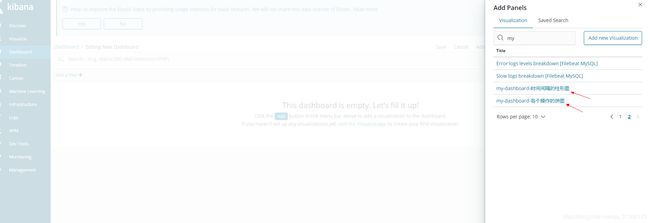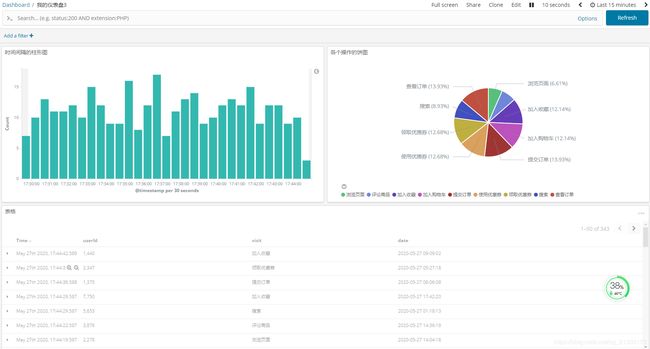综合练习
下面将所学习到的Elasticsearch + Logstash + Beats + Kibana整合起来做一个综合性的练习,目的就是让学生们能够更加深刻的理解Elastic Stack的使用。
1.1 、流程说明
- 应用APP生产日志,用来记录用户的操作
- [INFO] 2020-05-27 16:49:48 [cn.itcast.dashboard.Main] - DAU|9270|领取优惠券|2020-05-27 12:01:16
- [INFO] 2020-05-27 16:49:52 [cn.itcast.dashboard.Main] - DAU|2848|加入收藏|2020-05-27 09:06:18
- 通过Filebeat读取日志文件中的内容,并且将内容发送给Logstash,原因是需要对内容做处理
- Logstash接收到内容后,进行处理,如分割操作,然后将内容发送到Elasticsearch中
- Kibana会读取Elasticsearch中的数据,并且在Kibana中进行设计Dashboard,最后进行展示
说明:日志格式、图表、Dashboard都是自定义的。
1.2 、APP说明
APP在生产环境应该是真实的系统,然而,我们现在仅仅的学习,为了简化操作,所以就做数据的模拟生成即可。
业务代码如下:
package cn.itcast.dashboard;
import org.apache.commons.lang3.RandomUtils;
import org.joda.time.DateTime;
import org.slf4j.Logger;
import org.slf4j.LoggerFactory;
import org.springframework.boot.autoconfigure.SpringBootApplication;
@SpringBootApplication
public class Main {
private static final Logger LOGGER = LoggerFactory.getLogger(Main.class);
public static final String[] VISIT = new String[]{"浏览页面", "评论商品", "加入收藏", "加入购物车", "提交订单", "使用优惠券", "领取优惠券", "搜索", "查看订单"};
public static void main(String[] args) throws Exception {
while(true){
Long sleep = RandomUtils.nextLong(200, 1000 * 5);
Thread.sleep(sleep);
Long maxUserId = 9999L;
Long userId = RandomUtils.nextLong(1, maxUserId);
String visit = VISIT[RandomUtils.nextInt(0, VISIT.length)];
DateTime now = new DateTime();
int maxHour = now.getHourOfDay();
int maxMillis = now.getMinuteOfHour();
int maxSeconds = now.getSecondOfMinute();
String date = now.plusHours(-(RandomUtils.nextInt(0, maxHour)))
.plusMinutes(-(RandomUtils.nextInt(0, maxMillis)))
.plusSeconds(-(RandomUtils.nextInt(0, maxSeconds)))
.toString("yyyy-MM-dd HH:mm:ss");
String result = "DAU|" + userId + "|" + visit + "|" + date;
LOGGER.info(result);
}
}
}
部署:
#打包成jar包,在linux上运行
java -jar test-dashboard-generate-1.0-SNAPSHOT.jar
#运行之后,就可以将日志写入到/test/logs/app.log文件中
1.3、Filebeat
#vim test-dashboard.yml
filebeat.inputs:
- type: log
enabled: true
paths:
- /test/logs/*.log
setup.template.settings:
index.number_of_shards: 3
output.logstash:
hosts: ["112.126.93.218:5044"]
#启动
./filebeat -e -c test-dashboard.yml
1.4、Logstash
# vim test-dashboard.conf
input {
beats {
port => "5044"
}
}
filter {
mutate {
split => {"message"=>"|"}
}
mutate {
add_field => {
"userId" => "%{message[1]}"
"visit" => "%{message[2]}"
"date" => "%{message[3]}"
}
}
mutate {
convert => {
"userId" => "integer"
"visit" => "string"
"date" => "string"
}
}
}
output {
elasticsearch {
hosts => [ "112.126.93.218:9200","112.126.93.218:9201","112.126.93.218:9202"]
}
}
#output {
# stdout { codec => rubydebug }
#}
#启动
./bin/logstash -f test-dashboard.conf
1.5、Kibana
启动Kibana:
#启动
./bin/kibana
#通过浏览器进行访问
http://192.168.40.133:5601/app/kibana
1.5.1、时间间隔的柱形图

说明:x轴是时间,以天为单位,y轴是count数
保存:(my-dashboard-时间间隔的柱形图)
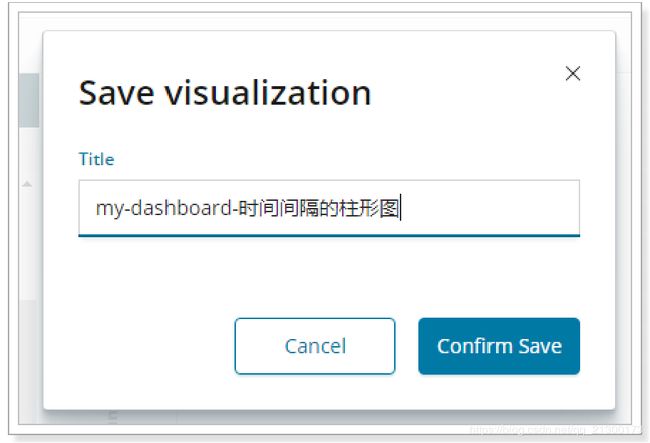
1.5.2、各个操作的饼图分布
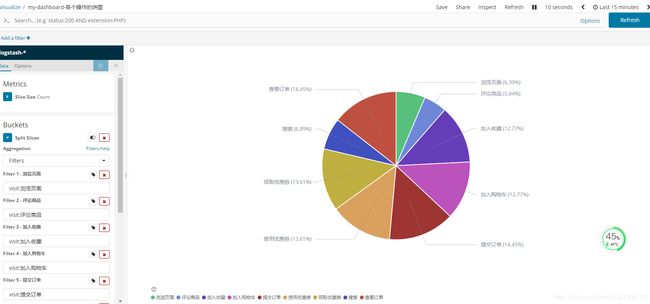
统计各个操作的数量,形成饼图。
保存:(my-dashboard-各个操作的饼图)
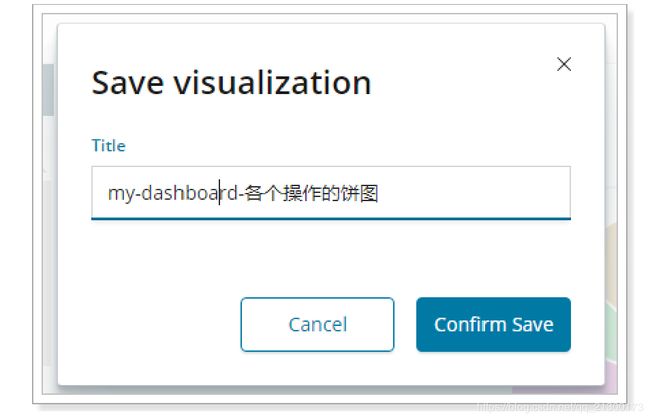
1.5.3、数据表格
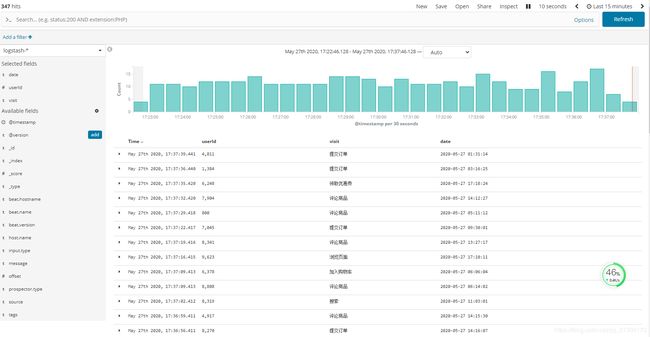
在数据探索中进行保存,并且保存,将各个操作的数据以表格的形式展现出来。
保存:(my-dashboard-表格)

1.5.4、制作Dashboard
把已经设计好的树状图、饼状图和表格以鼠标单机的方式添加进去



